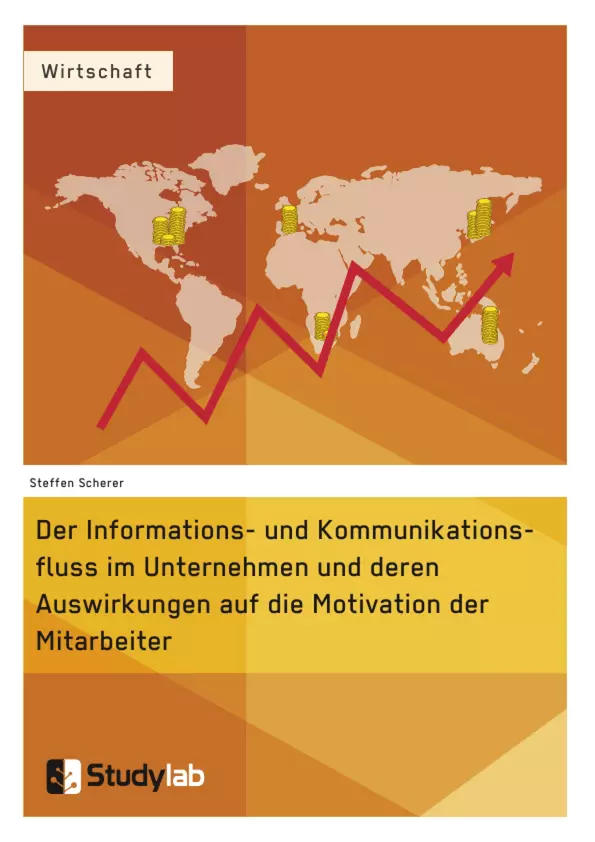Je besser der Kommunikationsfluss und Informationsfluss in einem Unternehmen organisiert ist, desto motivierter agieren dessen Mitarbeiter. Diese These wird in der vorliegenden Studie auf einen Prüfstein gestellt. Inwieweit kann man durch eine gelungene Kommunikation Mitarbeiter besser binden? Welche Arten von Kommunikation fördern am ehesten die Motivation? Wovon hängt Motivation ab, wie entsteht sie und – viel schlimmer – wie verliert man sie?
Weitere Ausgangspunkte und Annahmen der Studie gehen davon aus, dass ein besserer Kommunikationsfluss dann vorliegt, wenn viele persönliche Gespräche auf Face-To-Face-Basis stattfinden, die Intention des Senders vom Empfänger wahrgenommen und ausgeführt wird und sich motivierte Mitarbeiter dem Unternehmen gegenüber loyal verhalten.
Aus dem Inhalt:
- Theorie der Kommunikationsstile,
- Motivationstheorien im Fokus,
- Konflikte in der Kommunikation,
- Herausforderung beim Management des
Informationsflusses in Unternehmen,
- Mitarbeitermotivation durch Kommunikation,
- Empirische Studie und Hypothesenprüfung.
Inhaltsverzeichnis
- 1. Einleitung
- 1.1 Themenbegründung & persönliche Motivation
- 1.2 Problemstellung & Zielsetzung
- 1.3 Aufbau der Arbeit
- 1.4 Arbeitsmethode
- 2. Kommunikation
- 2.1 Theoretische Grundlagen der Kommunikation
- 2.2 Kommunikationsstile
- 2.2.1 Der selbstbezogene Stil
- 2.2.2 Der dramatisierende Stil
- 2.2.3 Der gewissenhafte Stil
- 2.2.4 Der kritische Stil
- 2.2.5 Der rational-distanzierte Stil
- 2.2.6 Der kooperative Stil
- 2.2.7 Der sensibel-vermeidende Stil
- 2.3 Kommunikationsmodelle
- 2.3.1 Kommunikationsmodell von Shannon und Weaver
- 2.3.2 Kommunikationsquadrat von Friedemann Schulz von Thun
- 2.3.3 Konstruktivistischer Ansatz nach Paul Watzlawick
- 2.3.4 Systemtheoretischer Ansatz nach Niklas Luhmann
- 3. Motivation
- 3.1 Begriffsdefinition
- 3.1.1 Intrinsische und extrinsische Motivation
- 3.2 Motivationstheorien
- 3.2.1 Die Hierarchie der Bedürfnisse nach Maslow
- 3.2.2 Die Zwei-Faktoren-Theorie nach Herzberg
- 3.2.3 Die Valenz-Instrumentalitäts-Erwartungs-Theorie nach Vroom
- 3.2.4 Die Equity-Theorie von Adams
- 3.3 Mitarbeitermotivation
- 4. Wechselwirkung der Kommunikation und Motivation im Unternehmen
- 4.1 Kommunikation im Unternehmen
- 4.1.1 Informationspolitik
- 4.1.2 Kommunikation zwischen Mitarbeiter und Führungskraft
- 4.1.3 Teamkommunikation
- 4.2 Konflikte in der Kommunikation im Unternehmen
- 4.3 Informationsfluss im Unternehmen
- 4.3.1 Herausforderung 1: Bewältigung der Informationsflut
- 4.3.2 Herausforderung 2: Von der Information zur Verständigung
- 4.4 Mitarbeitermotivation durch Kommunikation
- 4.4.1 Das Mitarbeitergespräch
- 4.4.2 Betriebliche Aktivitäten
- 4.4.3 Mitarbeiterbefragungen
- 4.4.4 Begegnungsräume im Arbeitsumfeld
- 4.5 Probleme der Motivation im Unternehmen
- 5. Empirische Studie
- 5.1 Beschreibung der Studie
- 5.2 Ableitung der Hypothese
- 5.3 Darstellung und Interpretation der Ergebnisse
- 5.3.1 Teil 3 des Fragebogens - Angaben zur Arbeitssituation
- 5.3.2 Teil 4 des Fragebogens – Kommunikation im Unternehmen
- 5.3.3 Teil 5 des Fragebogens – Motivation
- 5.3.4 Teil 6 des Fragebogens – Informationsfluss
- 6. Conclusio
- 6.1 Zusammenfassung
- 6.2 Hypothesenüberprüfung
- 6.3 Fazit und Ausblick
Zielsetzung und Themenschwerpunkte
Diese Arbeit befasst sich mit dem Informations- und Kommunikationsfluss im Unternehmen und dessen Auswirkungen auf die Motivation der Mitarbeiter. Ziel ist es, die Zusammenhänge zwischen Kommunikation, Informationsfluss und Mitarbeitermotivation zu analysieren und zu beleuchten, wie diese Faktoren sich auf die Arbeitsleistung und das allgemeine Wohlbefinden der Mitarbeiter auswirken.
- Theoretische Grundlagen der Kommunikation und Motivation
- Kommunikationsmodelle und -stile im Unternehmenskontext
- Mitarbeitermotivation durch Kommunikation
- Herausforderungen des Informationsflusses im Unternehmen
- Empirische Untersuchung der Zusammenhänge zwischen Kommunikation, Informationsfluss und Motivation
Zusammenfassung der Kapitel
Die Einleitung führt in das Thema ein, erläutert die Problemstellung und die Zielsetzung der Arbeit, sowie den Aufbau und die Arbeitsmethode. Kapitel 2 beleuchtet die theoretischen Grundlagen der Kommunikation und stellt verschiedene Kommunikationsmodelle und -stile vor. Kapitel 3 befasst sich mit dem Begriff der Motivation und verschiedenen Motivationstheorien. Kapitel 4 analysiert die Wechselwirkung von Kommunikation und Motivation im Unternehmen und untersucht die Auswirkungen von Kommunikation auf die Mitarbeitermotivation. Kapitel 5 präsentiert die Ergebnisse einer empirischen Studie, die die Zusammenhänge zwischen Kommunikation, Informationsfluss und Motivation untersucht. Die Conclusio fasst die wichtigsten Ergebnisse zusammen und gibt einen Ausblick auf zukünftige Forschungsfragen.
Schlüsselwörter
Kommunikation, Informationsfluss, Mitarbeitermotivation, Unternehmenskultur, Kommunikationsmodelle, Motivationstheorien, empirische Studie, Informationspolitik, Teamkommunikation, Mitarbeiterbefragungen, Arbeitsumfeld, Wohlbefinden.
- Quote paper
- Marisa Kobler (Author), 2016, Der Informations- und Kommunikationsfluss im Unternehmen und deren Auswirkungen auf die Motivation der Mitarbeiter, Munich, GRIN Verlag, https://www.grin.com/document/317441




